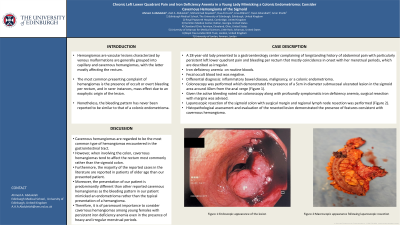Monday Poster Session
Category: Colon
P1999 - Chronic Left Lower Quadrant Pain and Iron Deficiency Anemia in a Young Lady Mimicking a Colonic Endometrioma: Consider Cavernous Hemangioma of the Sigmoid
Monday, October 28, 2024
10:30 AM - 4:00 PM ET
Location: Exhibit Hall E

Has Audio

Ahmed A. A. Abdulelah, MD
University of Edinburgh
Edinburgh, Scotland, United Kingdom
Presenting Author(s)
Ahmed A. Abdulelah, MD1, Zaid A. Abdulelah, MD2, Mohammad Alqaisieh, MD3, Dua' Al-Husni, MD4, Lina AlQirem, MD5, Yazan Gharaibeh, MD6, Amer Khatib, MD7
1University of Edinburgh, Edinburgh, Scotland, United Kingdom; 2Royal Papworth Hospital, Cambridge, England, United Kingdom; 3Hamilton Medical Center, Dalton, GA; 4Cleveland Clinic Foundation, Cleveland, OH; 5University of Arkansas for Medical Sciences, Little Rock, AR; 6Royal Free London NHS Trust, London, England, United Kingdom; 7University of Jordan, Amman, 'Amman, Jordan
Introduction: Hemangiomas are vascular lesions characterized by venous malformations are generally grouped into capillary and cavernous hemangiomas, with the latter mostly affecting the rectum. The most common presenting complaint of hemangiomas is the presence of occult or overt bleeding per rectum, and in rarer instances, mass effect due to an exophytic origin of the lesion. Nonetheless, the bleeding pattern has never been reported to be similar to that of a colonic endometrioma.
Case Description/Methods: A 28-year-old lady presented to a gastroenterology center complaining of longstanding history of abdominal pain with particularly persistent left lower quadrant pain and bleeding per rectum that mostly coincidence in onset with her menstrual periods, which are described as irregular. Additionally, it was noted that the patient has persistent iron deficiency anemia. Fecal occult blood test was negative. Colonoscopy was advised given the persistent iron deficiency anemia and abdominal pain to rule out inflammatory bowel disease, malignancy, or a colonic endometrioma.
Colonoscopy was performed which revealed the presence of a 5cm in diameter submucosal ulcerated lesion in the sigmoid area around 40cm from the anal verge. Given the active bleeding noted on colonoscopy along with profoundly symptomatic iron deficiency anemia, surgical resection with margins was advised. Accordingly, laparoscopic resection of the sigmoid colon with surgical margin and regional lymph node resection was performed. Histopathological assessment and evaluation of the resected lesion demonstrated the presence of features consistent with cavernous hemangioma.
Discussion: Cavernous hemangiomas are regarded to be the most common type of hemangiomas encountered in the gastrointestinal tract. However, when involving the colon, cavernous hemangiomas tend to affect the rectum most commonly rather than the sigmoid colon. Furthermore, the majority of the reported cases in the literature are reported in patients of older age than our presented patient. Moreover, the presentation of our patient is predominantly different than other reported cavernous hemangiomas as the bleeding pattern in our patient mimicked an endometrioma rather than the typical presentation of a hemangioma. Therefore, it is of paramount importance to consider cavernous hemangiomas among young females with persistent iron deficiency anemia even in the presence of heavy and irregular menstrual periods.
Disclosures:
Ahmed A. Abdulelah, MD1, Zaid A. Abdulelah, MD2, Mohammad Alqaisieh, MD3, Dua' Al-Husni, MD4, Lina AlQirem, MD5, Yazan Gharaibeh, MD6, Amer Khatib, MD7. P1999 - Chronic Left Lower Quadrant Pain and Iron Deficiency Anemia in a Young Lady Mimicking a Colonic Endometrioma: Consider Cavernous Hemangioma of the Sigmoid, ACG 2024 Annual Scientific Meeting Abstracts. Philadelphia, PA: American College of Gastroenterology.
1University of Edinburgh, Edinburgh, Scotland, United Kingdom; 2Royal Papworth Hospital, Cambridge, England, United Kingdom; 3Hamilton Medical Center, Dalton, GA; 4Cleveland Clinic Foundation, Cleveland, OH; 5University of Arkansas for Medical Sciences, Little Rock, AR; 6Royal Free London NHS Trust, London, England, United Kingdom; 7University of Jordan, Amman, 'Amman, Jordan
Introduction: Hemangiomas are vascular lesions characterized by venous malformations are generally grouped into capillary and cavernous hemangiomas, with the latter mostly affecting the rectum. The most common presenting complaint of hemangiomas is the presence of occult or overt bleeding per rectum, and in rarer instances, mass effect due to an exophytic origin of the lesion. Nonetheless, the bleeding pattern has never been reported to be similar to that of a colonic endometrioma.
Case Description/Methods: A 28-year-old lady presented to a gastroenterology center complaining of longstanding history of abdominal pain with particularly persistent left lower quadrant pain and bleeding per rectum that mostly coincidence in onset with her menstrual periods, which are described as irregular. Additionally, it was noted that the patient has persistent iron deficiency anemia. Fecal occult blood test was negative. Colonoscopy was advised given the persistent iron deficiency anemia and abdominal pain to rule out inflammatory bowel disease, malignancy, or a colonic endometrioma.
Colonoscopy was performed which revealed the presence of a 5cm in diameter submucosal ulcerated lesion in the sigmoid area around 40cm from the anal verge. Given the active bleeding noted on colonoscopy along with profoundly symptomatic iron deficiency anemia, surgical resection with margins was advised. Accordingly, laparoscopic resection of the sigmoid colon with surgical margin and regional lymph node resection was performed. Histopathological assessment and evaluation of the resected lesion demonstrated the presence of features consistent with cavernous hemangioma.
Discussion: Cavernous hemangiomas are regarded to be the most common type of hemangiomas encountered in the gastrointestinal tract. However, when involving the colon, cavernous hemangiomas tend to affect the rectum most commonly rather than the sigmoid colon. Furthermore, the majority of the reported cases in the literature are reported in patients of older age than our presented patient. Moreover, the presentation of our patient is predominantly different than other reported cavernous hemangiomas as the bleeding pattern in our patient mimicked an endometrioma rather than the typical presentation of a hemangioma. Therefore, it is of paramount importance to consider cavernous hemangiomas among young females with persistent iron deficiency anemia even in the presence of heavy and irregular menstrual periods.
Disclosures:
Ahmed Abdulelah indicated no relevant financial relationships.
Zaid Abdulelah indicated no relevant financial relationships.
Mohammad Alqaisieh indicated no relevant financial relationships.
Dua' Al-Husni indicated no relevant financial relationships.
Lina AlQirem indicated no relevant financial relationships.
Yazan Gharaibeh indicated no relevant financial relationships.
Amer Khatib indicated no relevant financial relationships.
Ahmed A. Abdulelah, MD1, Zaid A. Abdulelah, MD2, Mohammad Alqaisieh, MD3, Dua' Al-Husni, MD4, Lina AlQirem, MD5, Yazan Gharaibeh, MD6, Amer Khatib, MD7. P1999 - Chronic Left Lower Quadrant Pain and Iron Deficiency Anemia in a Young Lady Mimicking a Colonic Endometrioma: Consider Cavernous Hemangioma of the Sigmoid, ACG 2024 Annual Scientific Meeting Abstracts. Philadelphia, PA: American College of Gastroenterology.
